This article relies largely or entirely on a single source .(April 2024) |
Antonio Doria [lower-alpha 1] was one of the leaders of Ghibellines and Genoa, who became an Admiral of France, in 1339. He died on 26 August 1346.
This article relies largely or entirely on a single source .(April 2024) |
Antonio Doria [lower-alpha 1] was one of the leaders of Ghibellines and Genoa, who became an Admiral of France, in 1339. He died on 26 August 1346.
Antonio Doria was one of the leaders of Ghibellines and Genoa, whilst Charles of Monaco was in the Guelph party. During 1338, Philip VI of Valois had contracted for 20 galleys armed by the Ghibellines of Genoa and 20 other armed by the Guelphs of Monaco to serve in the French fleet.
Antonio Doria was in command of the 40 galleys. He is known as Aithon Doria in the General history of the Maison de France of father Anselme.
Antonio Doria was created Admiral of France in 1339. [1]
He died at the Battle of Crécy on 26 August 1346.
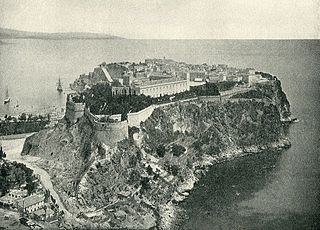
The early history of Monaco is primarily concerned with the protective and strategic value of the Rock of Monaco, the area's chief geological landmark, which served first as a shelter for ancient peoples and later as a fortress. Part of Liguria's history since the fall of the Roman Empire, from the 14th to the early 15th century the area was contested for primarily political reasons. Since that point, excepting a brief period of French occupation, it has remained steadily under the control of the House of Grimaldi.

The Guelphs and Ghibellines were factions supporting respectively the Pope and the Holy Roman Emperor in the Italian city-states of Central Italy and Northern Italy during the Middle Ages.

The Doge of Genoa was the head of state of the Republic of Genoa, a city-state and soon afterwards a maritime republic, from 1339 until the state's extinction in 1797. Originally elected for life, after 1528 the Doges were elected for terms of two years. The Republic was ruled by a small group of merchant families, from whom the doges were selected.
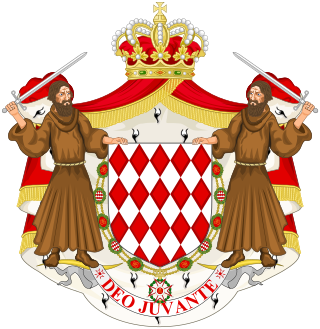
The House of Grimaldi is the current reigning house of the Principality of Monaco. The house was founded in 1160 by Grimaldo Canella in Genoa and became the ruling house of Monaco when Francesco Grimaldi captured Monaco in 1297.
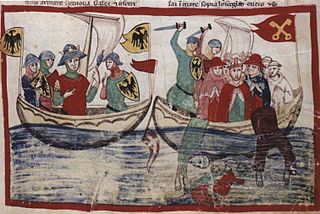
The naval Battle of Giglio was a military clash between a fleet of the Holy Roman Emperor Frederick II and a fleet of the Republic of Genoa in the Tyrrhenian Sea. It took place on Friday, May 3, 1241 between the islands of Montecristo and Giglio in the Tuscan Archipelago and ended with the victory of the Imperial fleet.

Lucien became Lord of Monaco on 11 October 1505, having murdered his predecessor and brother, Jean II, and held that sovereignty until his death.

The Battle of Ponza (1552) was a naval battle that occurred near the Italian island of Ponza. The battle was fought between a Franco-Ottoman fleet under Dragut and a Genoese fleet commanded by Andrea Doria. The Genoese were defeated and lost seven galleys captured. The battle made it easier for the Ottoman fleet to raid the coasts of Sicily, Sardinia, and Italy for the next three years.
Oberto D'Oria was an Italian politician and admiral of the Republic of Genoa, ruling the republic as Capitano del popolo.
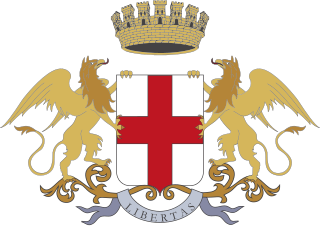
Giovanni di Murta was elected the second Doge of the Republic of Genoa after the resignation of Simone Boccanegra, on 25 December 1345. His dogate was dominated by his attempts to break the circle of political violence which had crippled the city over the past century and to reassert Genoese dominion over the Mediterranean colonies.

Nicolò Guarco was a Genoese statesman who became the 7th doge of the Republic of Genoa and led the Republic through the War of Chioggia against Venice.
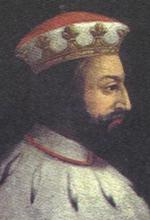
Giorgio Adorno was a statesman who became doge of the Republic of Genoa for two years. His father was Adornino Adorno and his mother Nicolosia della Rocca and his brother, Antoniotto, was elected four times as doge of the Republic. He was born c. 1350 but little is known about his youth except that he married Pietrina Montaldo, daughter of the doge Leonardo Montaldo. With her he had nine children, including the future doge Raffaele Adorno.

The Battle of Girolata was a naval action fought between Genoese, Spanish, and Ottoman ships on 15 June 1540 in the Gulf of Girolata, on the west coast of the island of Corsica, amidst the war between Charles V of Spain and Suleiman the Magnificent. A Spanish squadron of 21 galleys led by the Genoese Gianettino Doria and the Spaniard Berenguer de Requesens surprised an Ottoman squadron of 11 galleys, anchored at Girolata, led by the Ottoman admiral Dragut, whom the commander of the Ottoman Navy, Hayreddin Barbarossa, had committed to raid the Italian coast after his victories in the Adriatic sea the year before. As the crews of the Ottoman warships were ashore, distributing the booty from recent raids, the Spanish-Genoese fleet easily overtook them, taking all 11 Ottoman galleys and making 1,200 prisoners, among them Dragut, who was carried to Genoa and put, together with his captains, to row in Andrea Doria's galleys.

The Genoese navy was the naval contingent of the Republic of Genoa's military. From the 11th century onward the Genoese navy protected the interests of the republic and projected its power throughout the Mediterranean and Black Seas. It played a crucial role in the history of the republic as a thalassocracy and a maritime trading power.
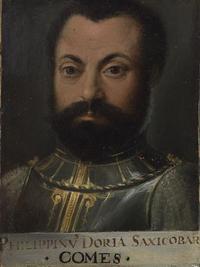
Filippo or Filippino Doria was a Genoese admiral from a cadet branch of the Doria family.
Guglielmo Boccanegra was a Genoese statesman, the first capitano del popolo of the Republic of Genoa, from 1257 to 1262, exercising a real lordship, assisted in the government by a council of 32 elders.
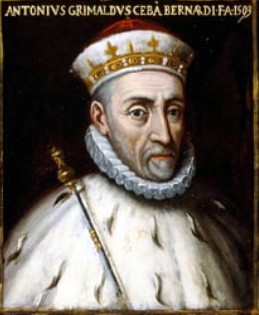
Antonio Grimaldi Cebà was the 79th Doge of the Republic of Genoa.

Giovanni Battista Lercari was the 64th Doge of the Republic of Genoa.

Agostino Doria was the 83rd Doge of the Republic of Genoa.
Simone Guercio was a Genoese noble and military commander and official in the service of the Republic of Genoa during the third quarter of the 13th century.